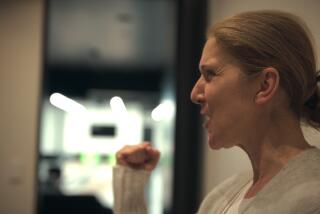For Sickle Cell Anemia Victim, Not Letting the Disease Win Is the Key : Therapist Refused to Let Painful Affliction Control Her Life; Now She’s in Trial of Promising New Drug
- Share via
As a child of five in Chicago, Camille McTeer Noldon was told she had sickle cell anemia and probably would die by the time she was 18. Now 36, she still struggles with the debilitating, hereditary blood disease but has learned to manage it better with the assistance of an experimental drug, Hydroxyurea, which she has been taking for three years in a clinical trial. Noldon, a Compton resident, talked with writer Catherine Gewertz.
When I was five, I fell off a bar stool in our kitchen. In the following days, I kept having chest pains. My mom took me to the University of Illinois at Chicago, where I was diagnosed with sickle cell.
As I got older, I began to understand more about the impact of sickle cell on me. One of the things that happens is that any stress, physical or psychological, can bring about a pain episode. I’d have to interrupt school to be hospitalized a lot.
It was hard for me, being a child and wanting to be with my peers. I’d have a pain episode and have to be taken away from school. It’s traumatic. Then I would return and everyone would say, “What’s going on? Are you going to die?” And they wouldn’t understand. People in the community were ignorant about the disease, and so they could be mean too.
*
The disease made me more serious than my peers. Already at that age, I knew it was a privilege to be in school. I would struggle to keep up because I knew I didn’t have any time to waste.
In 1972, the National Institutes of Health opened a sickle cell center in Chicago at the University of Illinois. It was one of 10 centers around the country. I became involved there, getting treatment as well as participating in the community education they were doing. I would go out and talk at workshops for teachers or students.
In high school, I was at a prestigious private school, and the teachers were more understanding. But I had trouble in the winter, especially, because the cold in Chicago made my pain worse. There were frequent hospitalizations. But I graduated on time.
I went on to graduate from Loyola University in Chicago, on the dean’s list. Then I got my master’s degree. Now I’m a family therapist.
Early on, I made a decision that this disease would not control my life. It was scary and was always in my head, but my family was strong in faith, and I had two choices: I could live like I was going to die, or live like I was going to live. There was no gray area.
*
Now I do have to miss work sometimes. Over the years, I’ve had my spleen and gall bladder removed. I’ve had a bowel obstruction and a retina detachment. Lately, I’ve been having aseptic necrosis of the hip, in which the blood supply to the bones is not what it should be, so the bones deteriorate. I had hip replacement surgery recently in my right hip and soon will have it in my left.
When your blood cells are sickle-shaped, like mine, they don’t have the 120-day life span of normal red blood cells. They only live about 60 days, so my organs work extra hard because they don’t get the red blood-cell supply, and the oxygen isn’t as plentiful as it should be. That’s why you get these secondary complications.
The primary symptoms are the pain episodes. It’s paramount that I manage stress in my life, since stress brings on the pain. And I have learned that stress is something I really can keep under control.
I am also more susceptible to colds and flu, so I have to be careful about not exposing myself to illness.
There is still a lot of ignorance about the disease. When I was younger, people would ask me, “Is it contagious?” They didn’t take the opportunity to get to know me. All they would know is, she’s sick, and they would push me away. Since then, I’ve come to understand that people are really just struggling with their own insecurities when they act that way.
Growing up, what you would hear is that there is no cure, you only treat symptoms. So I would get pain medication, anything from Tylenol to morphine.
When I got to sixth grade, doctors thought blood transfusions would help. So once a month through high school, I did that. It certainly helped. I felt better and had pink cheeks again.
But the summer after high school, I got a new hematologist who said the transfusions were nonsense and stopped them. So I started having pain crises again and was taking more pain medication.
In recent years, doctors had been giving me folic acid tablets. Then, in 1992, I enrolled in a study at the University of Illinois for a new drug, Hydroxyurea. When I moved to Southern California in August, my doctors in Chicago referred me to Dr. Cage Johnson at USC so that I could continue taking the medication. The study period is over in about three months.
One of the side effects of the drug is weight gain. I have gained about 60 pounds since I started the drug in 1992. Some people get itchy skin, hair loss or vomiting, but I have had only minimal trouble with those.
I feel much more energetic on this drug. I’m glad I don’t have to take pain medication, because that stuff makes me feel slow and depressed. I have more assurance that I’m going to get through the day, that life can be full, that I can plan things.
I even got married in December.
I am ecstatic to be part of this historic process. I really think parents should be hopeful and give their children hope.






